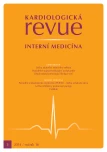Regular supraventricular tachycardias – diagnosis, treatment and the experiences of a high‑capacity cardio centre
Authors:
J. Haniš 1; A. Bulava 1,2; M. Eisenberger 1,2; D. Sitek 1; A. Novotný 1; F. Toušek 1
Authors‘ workplace:
Kardiologické oddělení, Kardiocentrum, Nemocnice České Budějovice
1; ZSF JU v Českých Budějovicích
2
Published in:
Kardiol Rev Int Med 2014, 16(3): 178-184
Category:
Cardiology Review
Overview
Aim:
The aim of our study is a retrospective review of non‑pharmacological treatment of the most commonly occurring regular supraventricular tachycardias with an emphasis on safety and effectiveness.
Methods:
We included the data of all our consecutive patients diagnosed with an accessory pathway (AP) and/ or AV reentry tachycardia (AVRT), AV nodal reentry tachycardia (AVNRT) and typical atrial flutter (AFL), who were treated in our centre using radiofrequency catheter ablation (RFA) between 2008 and 2012.
Results:
In total, we conducted 1,168 ablations, comprising 141 procedures for AVRT/ AP, 383 procedures for AVNRT and 644 procedures for AFL. The acute success rate was 98.1% for AVRT/ AP, 98.6% for AVNRT and 99.8% for AFL. The incidence of complications was 1.03% in all procedures. Success and complication rates in our centre are consistent, and often more favourable in comparison with the literature.
Conclusion:
In patients with SVT, RF catheter ablation is a highly effective and safe method.
Keywords:
supraventricular tachycardias – radiofrequency ablation – atrioventricular reentry tachycardia – atrioventricular nodal reentry tachycardia – typical atrial flutter
Sources
1. Hindricks G. The Multicentre European Radiofrequency Survey (MERFS): complications of radiofrequency catheter ablation of arrhythmias. The Multicentre European Radiofrequency Survey (MERFS) investigators of the Working Group on Arrhythmias of the European Society of Cardiology. Eur Heart J 1993; 14: 1644– 1653.
2. Scheinman MM, Huang S. The 1998 NASPE prospective catheter ablation registry. Pacing Clin Electrophysiol 2000; 23: 1020– 1028.
3. Calkins H, Yong P, Miller JM et al. Catheter ablation of accessory pathways, atrioventricular nodal reentrant tachycardia, and the atrioventricular junction: final results of a prospective, multicenter clinical trial. The Atakr Multicenter Investigators Group. Circulation 1999; 99: 262– 270.
4. Spector P, Reynolds MR, Calkins H et al. Meta‑analysis of ablation of atrial flutter and supraventricular tachycardia. Am J Cardiol 2009; 104: 671– 677.
5. Bohnen M, Stevenson WG, Tedrow UB et al. Incidence andpredictors of major complications from contemporary catheter ablation to treat cardiac arrhythmias. Heart Rhythm 2011; 8: 1661– 1666. doi: 10.1016/ j.hrthm.2011.05.017.
6. Eisenberger M, Bulava A, Fiala M. Základy srdeční elektrofyziologie a katetrových ablací. Praha: Grada 2012.
7. Morady F. Catheter ablation of supraventricular arrhythmias: state of the art. Pacing Clin Electrophysiol 2004; 27: 125– 142.
8. Nakagawa H, Jackman WM. Catheter ablation of paroxysmal supraventricular tachycardia. Circulation 2007; 116: 2465– 2478.
9. Pappone C, Radinovic A, Santinelli V. Sudden death and ventricular preexcitation: is it necessary to treat the asymptomatic patients? Curr Pharm Des 2008; 14: 762– 765.
10. Silva G, de Morais GP, Primo J et al. Aborted sudden cardiac death as first presentation of Wolff‑ Parkinson‑ White syndrome. Rev Port Cardiol 2013; 32: 325– 329. doi: 10.1016/ j.repc.2012.08.015.
11. Lesh MD, Van Hare GF, Scheinman MM et al. Comparison of the retrograde and transseptal methods for ablation of left freewall accesory pathways. J Am Coll Cardiol 1993; 22: 542– 549.
12. Natale A, Wathen M, Yee R et al. Atrial and ventricular approaches for radiofrequency catheter ablation of left‑ sided accessory pathways. Am J Cardiol 1992;70: 114– 116.
13. Sacher F, Wright M, Tedrow UB et al. Wolff‑ Parkinson‑ White ablation after a prior failure: a 7‑year multicentre experience. Europace 2010; 12, 835– 841. doi:10.1093/ europace/ euq050.
14. Inoue S, Becker AE. Posterior extensions of the human compact atrioventricular node: a neglected anatomic feature of potential clinical significance. Circulation 1998; 97: 188– 193.
15. Jackman WM, Beckman KJ, McClelland JH et al. Treatment of supraventricular tachycardia due to atrioventricular nodal reentry by radiofrequency catheter ablation of slow‑ pathway conduction. N Engl J Med 1992; 327: 313– 318.
16. Aldhoon B, Kautzner J. Komplikace katetrizační ablace srdečních arytmií. Interv Akut Kardiol 2013; 12: 135– 140.
17. Stárek Z, Eisenberger M, Zaoral L et al. Radiofrekvenční katetrizační ablace supraventrikulárních arytmií, historie a současnost. Interv Akut Kardiol 2006; 3: 122– 130.
18. Blomstrom‑ Lundqvist C, Scheinman MM, Aliot EM et al. ACC/ AHA/ ESC guidelines for the management of patients with supraventricular arrhyth-mias – executive summary: a report of the American College of Cardiology/ American Heart AssociationTask Force on Practice Guidelines and the European Society of Cardiology Committee for Practice Guidelines (Writing Committee to Develop Guidelines for the Managementof Patients With Supraventricular Arrhythmias). Circulation 2003; 108: 1871– 1909.
19. Pařízek P, Haman L, Dostálová H et al. Dlouhodobé výsledky katetrizační ablační léčby u supraventrikulárních tachyarytmií. Vnitr lek 2011; 57: 546– 550.
Labels
Paediatric cardiology Internal medicine Cardiac surgery CardiologyArticle was published in
Cardiology Review

2014 Issue 3
Most read in this issue
- Diverticular disease of the colon – new trends in therapy
- Irritable bowel syndrome – diagnosis and treatment
- Chronic pancreatitis
- Proton pump inhibitor treatment
